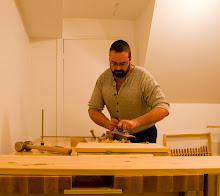Recently a thread started on the Canadian Woodworking forum that included the notion of refurbishing a Crown Gent's Saw. A suggestion that I made was not taken gladly by some, so I've decided that I will refurbish my own elderly Crown Gent's Saw in the interest of proving the point that the method works.
First, the saw. Here it is in its crappy glory.

It will be refurbished into a dovetail saw, so for that it will need a rip-pattern tooth form, and it needs to have its set radically reduced. First, reduce the set. Take a pair of hardwood blocks and lay the saw between them. With raps of a hammer you can squeeze the teeth together to reduce the set. Depending on the size of your blocks, it can take a surprisingly hard hit. Below is the setup that I used for reducing the set. A chunk of red oak (would have preferred something harder) with another piece of red oak as a 'punch'.

Once the set was reduced it was time to file. I put the sad saw in the saw vise and got out my smallest saw file - brand-spanking-new. Only the best for the crappy old Crown Gent's Saw. :)

Now to file it to a rip cut. First I ran a mill file over the top to joint the saw. Not that I expected the jointing to be off... this saw had never been sharpened (or used, really) so the teeth should be in factory condition, but by taking a light jointing pass I can more easily see where I am in the filing process. After filing the saw I tried it out. I had done two test kerfs in a piece of white pine before starting on refurbishing the saw. The test board can be seen below. The two 'before' kerfs are each the result of 50 strokes of the saw. The 'after' kerf is the result of only 12 strokes of the saw, and I had to stop because the spine had hit the top of the board and I could go no deeper. The saw now cuts fast and straight, and all for about 20 minutes of effort. If I had it to do over again I would have done some more beating on the wooden blocks to reduce the set even more. The last kerf in the test board is from my Medallion dovetail saw. Only 8 strokes. Nice. Much longer saw, though, so it has a bit of an advantage, there.

Anyway, that was my refurbishing of a Crown Gent's Saw. It's not hard, so if you have one that you hate then have a go at fixing it up.

No comments:
Post a Comment